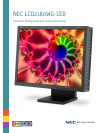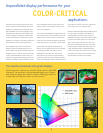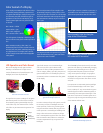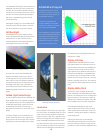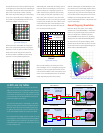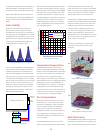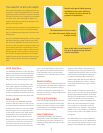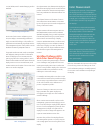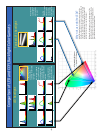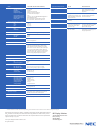
Color displays are additive color devices. Color
is formed by adding different proportions of
red, green and blue light. These primary colors
are formed by the glow of different types of
phosphors in the case of a CRT display, or by
filtering white light into red, green and blue
on an LCD.
Red + Green = Yellow
Green + Blue = Cyan
Blue + Red = Magenta
Red + Green + Blue = White
The color gamut of a display is limited by how
pure in color the red, green and blue primaries
are.
When viewed on a CIE xy color chart (a 2
dimensional plot of all colors visible to the hu-
man eye), the red, green, and blue primary col-
ors together form a triangle. Colors outside
of this triangle are outside of the displayable
color gamut.
LCD Operation and Color Gamut
With an LCD display, the color gamut is deter-
mined by a combination of the light source
used to illuminate the LCD panel (known as the
backlight) and of the LCD panel itself.
Each pixel on the screen is made up of red, green
and blue sub-pixels. The colors of these sub-pix-
els are made by passing the backlight through
a color filter array. The characteristics of these
color filters in part determine the gamut of the
display.
Typical LCD monitors use a broad-band light
source such as CCFLs, which radiate a wide
spectrum of colors, including unwanted colors
such as oranges, yellows, cyans. Only the pure red,
green and blue parts of the backlight spectrum
are wanted in order to maximize the color gamut
of the display.
In order to achieve a larger color gamut, it would
be necessary to filter the backlight into a nar-
rower spectrum of colors thus producing purer
red, green and blue. However, filtering into a nar-
rower spectrum is a technological challenge and
doing so also reduces the total amount of light
that is transmitted through the filter. This means
that the overall screen luminance is reduced or
must be compensated for by using more CCFL
backlights.
The LCD2180WG-LED avoids the need for narrower
spectrum color filters by fundamentally changing
the spectrum of the backlight source. By using
red, green and blue power LEDs, which output
a very narrow spectrum of light, a huge gain in
displayable color gamut can be achieved without
the need for using narrower color filters on each
sub-pixel.
It is important to understand that the backlight
for the LED based display is still “white” light,
but it is made up of very narrow-band red, green
and blue light, which when combined together, is
perceived by the human eye as white light. If this
light were to be shown as a rainbow spectrum us-
ing a prism, only the red, green and blue portions
of the rainbow would be seen.
Color Gamut of a Display
The size and position of the triangle are de-
termined by the purity of the primary colors.
The purer the color, the closer it is to the edge
of the CIE horseshoe. Colors along the edge of
the horseshoe are made up of pure monochro-
matic light.
The largest possible color gamut using 3 colors
would be obtained by using 3 monochromatic
light sources such as LASERs.
When a light source is viewed as a spectrum, it
is possible to see the relationship between it’s
spectrum and position on the CIE color chart.
Monochromatic Light lies along the
edge of the CIE horseshoe
Light made up of a broader spectrum
lies inside the CIE horseshoe.
Light Wavelength (nm)
400
700
500
600
Relative Intensity
Light Wavelength (nm)
400
700
500
600
Relative Intensit
y
Typical CCFL Backlight Spectrum
Combined LED Backlight Spectrum
Backlight
TFT Array
Liquid Crystal
Color Filter Array
LCD Screen Sub-Pixel Structure
LCD Color Filter Array
Light Wavelength (nm)
400
700
500
600
Relative Intensity
Light Wavelength (nm)
400
700
500
600
Relative Intensity
3



